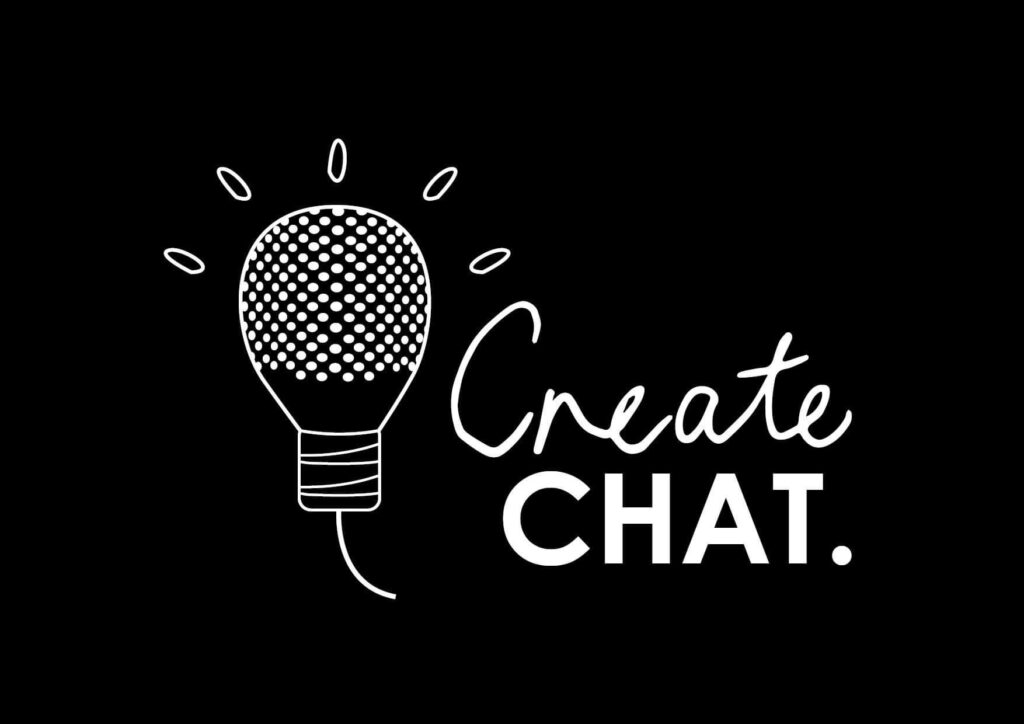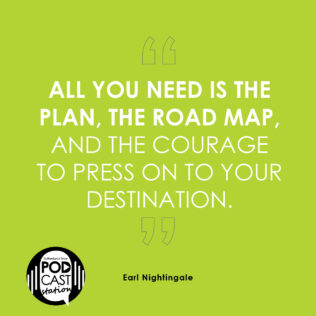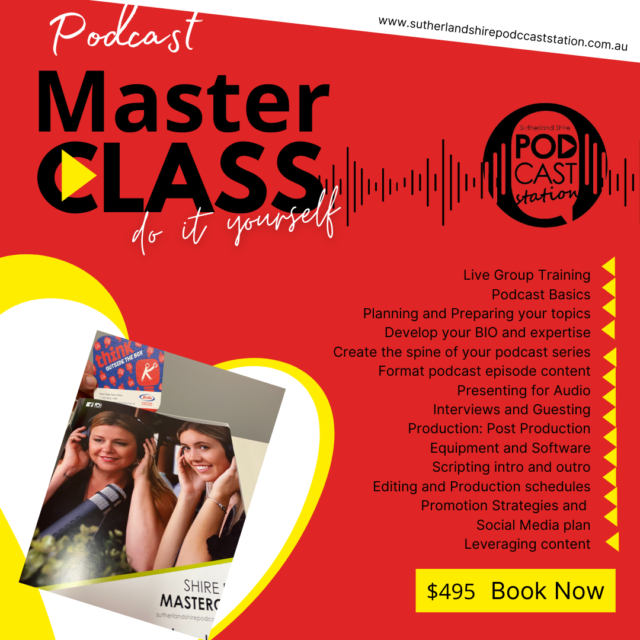Podcasts are booming.
You’ve heard it before, and with good reason. With more than 750,000 podcasts in the podcast ecosystem spanning everything from detailed narrative productions, to conversation style programs, there is still room for more with trends heading towards fiction and reality podcasting.
Hhhhhmmmmm I here you say! That gives me an idea!
To date, more than 50 Billion podcasts have been downloaded since 2014 just through iTunes and the Apple Podcast platform and with Spotify and Audible aggressively entering the space, it’s a no brainer that brands and businesses are now jumping in and creating their own podcast series. What better way to market your message than record the conversation you want to have with your potential clients without even having to speak to them first.
However, brands often make a number of mistakes when they create their own shows. Here are five of the top podcast production mistakes we see corporations making:
1. Choosing a terrible name
It’s possibly the most important aspects of creating any podcast, let alone a branded show. A show name will determine whether people discover or choose your content in a podcast app, whether they remember the show name after hearing advertising about it, as it can communicate the story of the podcast, and it can define the feel of your podcast.
Choosing a podcast name that matches some of your existing marketing strategy may help with recognition but that familiarity suggests that the message will be the same, and they already know it. People don’t want to listen to a show about your company, your advertising slogan has the potential to alienate your listeners as they will simply think it’s a ‘sell’. Attracting a new audience or engaging your current is about providing content that is of value, credible and helps them in some way. Also unless you are doing a show about podcasts and their creation – don’t ever choose a name that includes the word ‘podcast’, – podcast is the medium so it doesn’t need to be in the name. Coming up with something simple and interesting, a phrase that is common or a saying that resonates is more likely to get people to download the show. Create curiosity and Brand Lift
At ShirePod, we suggest finding a show name that is less than four words, ideally one or two. Abstract, but it should speak to the content of the show. The easier you can make your show name to remember, the more likely is people will talk about it and share it with friends.
Here are some of our favourite branded podcast names along with the organisations that produced them:
Now She’s Talking. ShirePod / Her Sports Broadcasting
Create Chat. Wordstyler / Daydream Creative
Shattered Ceiling. Wordstyler / ShireWomen
Tell me more about that. Wordstyler / Pip Raedio
Elements of Empowerment. Pip Rae / Shire Pod
Two P’s in a Comedy Pod Shire Pod. Wordstyler / Local Comedians
The Late Night Chef. Shire Pod / Chef Collective
2. Designing your own artwork
Artwork is one of THE MOST important aspects of show discovery. You are competing in a pool of 750,000 episodes and you want to have your podcast stand out. The artwork might be seen small in an app or large on an Apple TV and so it needs to work well in all applications. Great podcast artwork is bold, easy to read, and communicates the story of your show.
In Australia we’ve found a lot of brands wanting to handle the creative, visual elements of a podcast themselves and we understand this. Design teams have great ideas and best of intentions, but often struggle to see outside the branding box. (see 1st mistake) You may end up with artwork that carries too much brand messaging and is a turn-off to potential listeners.

At ShirePod we recommend using a graphic designer, like Daydream Creative who can ensure that your artwork looks good on every platform and directory. It has to communicate the message of your shows in a simple glance. An illustrator who understands packaging is more likely to create a detailed masterpiece that will entice, engage and inspire the listener to at least test your content. A great design will look good on other businesses media pages. This design will help sell the concept of your shows and build a community they are proud to belong to.
3. Big ideas on a tiny budget
Budgets can blow out any project and in the podcast space they can impact on the success of a show and the return on your investment.
At ShirePOD we are approached by clients who want their podcast to sound and feel like a box office movie with a lunch order budget. It’s important to understand the elements that go into producing a podcast episode, let alone a series. This is an important conversation. Podcasting is most commonly used as a marketing tool, and I would say possibly the most effective content creator around. But like any marketing strategy the true cost of ideation, research, planning, execution, production, post production, and promotion takes time, money and energy. Whilst some brands will happily spend a million dollars on a single spot television campaign despite audiences flocking from TV in droves, when it comes to podcast content they struggle to get these projects across the line when faced with the price. So what does it actually cost to make a narrative podcast?
Narrative podcasts take time and resources to produce effectively and should be considered as closer to a TV or radio budget rather than social media.
A narrative series has a time line, story board and messaging ark. The development of story takes time and may include a number of people to become involved in the project.
- How many episodes? How many interviews? How much audio ambiance? Travel?
- Scripting of episodes is a skill and often needs to be approval.
- Presenting a show with engaging taMilent or a host skilled in questioning is an investment.
- Targeting what type of audience and how often will influence time spent on each phase of production.
Depending on the type of show – and the complexity of the narrative – in Australia a brand could easily spend $70,000 or more on the production of a 6-10 episode series.
That cost would buy you a skeleton team of producers for around three months, and you would then factor in a marketing budget on top. We always recommend allocating a marketing budget that matches the cost of production, and focus those resources on in-podcast advertising. A good production team should be able to handle both the creation and marketing of a show.
To put this in perspective, unless you are striving for the number 1 spot on Apple iTunes or to be the winner of Webby Awards (a production and marketing budget of around a cool $500K) Complex narrative storytelling experiences will take a little longer but will produce a quality standard by which all branded podcasts are measured. It has to be light on the brand messaging. Heavy on content which is truly unique and captivating.
Now you don’t need a $500,000 production budget to make a compelling podcast, you can make a compelling show for a fraction of that, but it certainly helps to think of your podcast in the same way you think of a television spot. If your brand is spending a million dollars on a television campaign, perhaps you should think about diverting some of that money towards podcasts.
Podcasts change the way people feel, think and act. It develops connection through our strongest communication, verbal. Saying what you mean, meaning what you say. Showing up, Sharing and Speaking Up creates the change you want to see in the world.
4. Making shows internally
Now anyone can create a podcast and you don’t need fancy equipment. For less than the cost of your phone and a $90 mic you are on your way. That is why podcasts are so popular. They’re one of the most accessible forms of content creation that can be easily pulled apart and repurposed for social media and other communication channels like blogs, newsletters and promotion material. So it’s probably no surprise that a lot of brands decide to make their own, internally.
Many corporations, organisations and education faculties have a media and content creation team tasked with writing content for the website or they may engage a video producer and task them with making a podcast, on top of the work they already do. As already mentioned, Podcasting a narrative, interviews or educational content takes time. A half hour podcast can take around 10 hours from planning, production and promotion with each phase requiring specific skill sets. Attending a masterclass, like the one ShirePod hosts every quarter will help you develop your intro, Outro, Scripts, Series and Episode content as well as popular marketing strategies.
I know you want to produce a show that people listen to and there are plenty of bad examples of ‘press record’ podcasts. So getting the basics right like putting in the planning work, getting the story written for audio dynamics and find the presenter to deliver the podcast require an understanding of sound design and listener experience. Even though you have a great blog writer and videographer who is willing to be trained in audio writing and production, it will take time to be efficient and podcasting has this thing that if people don’t like the episode they are unlikely to engage any further, assuming it is all going to be the same quality.
As an example, as audio consumers we have become accustomed to its sound and presentation and any radio host will tell you of the different skill set required to create ‘theatre in the mind’ which is unlike TV and Video that have visual messaging recognition cues to help us understand, even when the message is off. So if the quality of the recording is poor, and the content was not that exciting the listener will experience deterrence and is unlikely to recommend it to other people, even though it’s an interesting topic.
So if you still want to do it yourself for interest, development or increase your skill set, at least hire an industry expert to coach you on all aspects of podcast creation and to keep you accountable. See our article about PodFade, it’s a real thing.
5. Forgetting about the audience
Who are you talking to? It’s admirable to be creating “a podcast’, but it’s important to create the content for your audience so they will actually listen to you. If you don’t reach an audience then what’s the point.
Edison Research shows that 89% of new podcast listeners are below the age of 55. The top three reasons people listen to podcasts are to
- learn new things,
- be entertained,
- stay up-to-date.
People aren’t actively looking for ways to engage with your brand, so you need to focus on entertaining them with the information you want to share. That really comes down the creative format that podcasting provides. Podcasts are not regulated like usual media, whilst some may require a warning about language, violence or triggers, they are not subjected to the same legislation as mainstream media………YET.
The format of your podcast can be simple or complex, contain interviews or news grabs, sound effects and music, narrative or the conversational talk show style. It’s all up to you and extends the creative boundaries in terms of listening. Segments and guests are very entertaining, remembering to serve your listeners with the stuff they can’t google. It’s the perfect opportunity to take the listener on a journey, diving into issues and create compelling content that keeps them coming back.
Your audience will thank you for the innovation of content they can’t find anywhere else. So start brainstorming your ideas and reach out if you would like one of the ShirePod experts to facilitate training or navigate the awesome possibilities of your podcast series. Check out our roadmap for Podcast Creation.
Bonus Material.
PodFade – It’s a thing. It’s when you can no longer be bothered to create your podcast because you have worked out how much time, energy and money goes into producing the episodes and you may not be seeing the results you had hoped for. ShirePod looks are all three phases. Planning, Production and Promotion. For more information about these click here. We have specialist coaches in creative writing for radio presenting, technical production and editing with access to strategists in marketing and promotion across social media. So if you want to know more about PodFade or need help pushing through this invisible barrier, get in touch.




